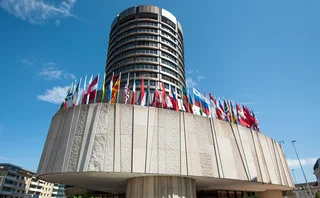
Subprime and punishment
The subprime crisis is moving from the boardroom to the courtroom and Wall Street is in the dock. The number of class action lawsuits rose sharply last year, and more are expected to follow in the coming months. Are further huge losses around the corner for investment banks? Peter Madigan reports

The fallout from the subprime mortgage crisis has started to mushroom. While early attention focused on the multi-billion-dollar writedowns at investment banks, monolines and hedge funds, the consequences are now beginning to be felt more widely. In particular, financial institutions are bracing themselves for a wave of class action lawsuits from disgruntled investors, hit by plunging prices on residential mortgage-backed securities and collateralised debt obligations referenced to subprime loans.
Even given the scale of the credit crisis, the sheer volume of the subprime litigation now moving through US courts is staggering. A comprehensive report on subprime litigation released by Chicago-based Navigant Consulting last month revealed that 2007 saw 278 subprime-related lawsuits filed in federal courts across the US, ranging all the way from borrower class action suits brought by individual homeowners who did not understand the terms of their loans, to securities cases filed by institutional investors.
More surprising is the fact that almost every participant in the mortgage process has been named as a defendant in one or more suits, with mortgage bankers and loan correspondents being the most popular target, followed by mortgage brokers, lenders, appraisers, title companies, homebuilders, servicers, issuers, investment banks (in the guise of underwriting firms and securitisation trustees), bond insurers and rating agencies.
Beyond those cases filed at federal level, anecdotal evidence suggests there may be thousands more suits being pursued at state level on behalf of a myriad of plaintiffs, including civil rights groups such as the National Association for the Advancement of Colored People, alleging racial discrimination in the lending of subprime mortgages, and local communities that have been devastated by mass foreclosures.
Two such entities that have filed suits with state and local courts are the cities of Cleveland, Ohio and Baltimore, Maryland. While these two cases are unusual in that they have been brought by city authorities rather than private enterprises, they have one other distinguishing feature - both are seeking damages against the investment banks that securitised pools of subprime mortgages, rather than the mortgage originators that lent money to borrowers in the first instance.
These cases appear to be the exception rather than the rule. While the Navigant report found that 32% of suits had been filed against state-licensed mortgage banks (see figure 1), only 7% were brought against securities brokers, dealers and flotation companies for the part they played in securitising loans.
The case brought by the City of Cleveland is particularly notable for accusing 21 financial institutions, including 12 Wall Street banks, of breaking Ohio public nuisance laws by contributing to the 7,000 foreclosures the city recorded in 2007 - in turn, depressing the land values of entire swaths of inner city districts and aggravating social problems such as squatting, arson and violent crime. The key contention in the suit is that "responsibility for Cleveland's plight rests principally with securitisers that actually provided cash used to make loans, regardless of the lender or broker nominally involved in the transactions".
Risk attempted to speak to Cleveland law director, Robert Triozzi, but he declined to comment, citing the inability to discuss a pending legal action. Nonetheless, lawyers unaffiliated with the suit believe the investment banks have little to worry about in this instance.
"The Cleveland case would be best described as 'out there'. Rather than pursuing a public nuisance law, a better attempt might be made arguing an 'aiding and abetting' claim, but then the plaintiff would have to prove that the securitiser had both actual knowledge of criminal conduct by mortgage originators and provided substantial assistance in the commission of that crime. It's hard to argue the routine purchase of mortgage loans constitutes substantial assistance," says Larry Platt, partner and leader of the mortgage banking practice at Washington, DC-based law firm K&L Gates.
A suit filed by the City of Baltimore against Wells Fargo is predicated along similar lines - that several districts of the city have suffered degradation due to large-scale foreclosures. The plaintiff alleges the bank "engaged in a practice of unfair, deceptive and discriminatory lending activity in Baltimore's minority neighbourhoods". Once again, lawyers are sceptical higher concentrations of foreclosures in predominantly African-American districts are due to reverse redlining, a practice that targets areas for predatory lending patterns due to ethnic composition, rather than cold hard economics.
"Wells Fargo's underwriting process is race blind, so Baltimore has to illustrate there is a racial element to its underwriting," explains Bill Holley, a partner specialising in banking, securities and real estate at Atlanta-based law firm Parker, Hudson, Rainer & Dobbs (PHR&D). "The problem is, if I can show you there is a disproportionate number of people with incomes of under $30,000 living in a certain part of the city, and they are provided with mortgages at higher interest rates than borrowers making $50,000, and applying for a bigger mortgages with lower interest rates, then you will have difficulty alleging it is a race-based decision. The underwriting criteria are built simply upon income, credit score and the size of the mortgage being sought - that is how the models are built."
Legal counsel representing Baltimore failed to return calls for comment, but independent lawyers believe both this case and the Cleveland suit are unlikely to reach full trial and will probably be concluded after the discovery phase with a summary judgement motion to halt proceedings. This analysis corresponds with the resolution of many of the subprime suits that were brought to a close by the end of 2007.
While 90% of the cases identified in the Navigant report were still active going into 2008, 5% had been dismissed, 3% resulted in a default judgement after one party failed to appear and the remaining 2% were stayed or settled. The default judgements are hardly surprising given that more than 220 mortgage lenders have ceased trading since late 2006, including high-profile casualties such as New Century Financial Corporation and Countrywide Financial Corporation, respectively the second- and third-biggest subprime lenders in the US in 2006.
Although suits such as those brought by Baltimore and Cleveland look unlikely to trouble dealers, some are concerned stronger suits could emerge over the course of 2008. Already, the first major settlement of a subprime-related suit has been made by Merrill Lynch (see box).
On January 3, Boston-based State Street Corporation announced it would set up a $618 million reserve "to address legal exposure and other costs associated with the underperformance of certain active fixed-income strategies and customer concerns as to whether the execution of these strategies was consistent with the customers' investment intent". The strategies in question had been "adversely impacted by exposure to, and the lack of liquidity in, subprime mortgage markets," the firm stated.
State Street is currently facing six lawsuits filed by five pension funds pertaining to violations of the Employee Retirement Income Security Act and breaches of securities law, and a suit by a healthcare provider alleging breach of contract and fraud. What all six share is a contention that State Street altered the investment strategies of the funds and took undisclosed highly leveraged positions in mortgage-related financial derivatives without advising the participant investors.
State Street declined to comment, but legal professionals speculate the fact that the firm has established a dedicated litigation fund indicates it feels the suits are not without merit. More generally, lawyers suggest securities fraud and the misrepresentation of the terms of a security, in particular, may emerge as the biggest and most serious litigation issue investment banks will face.
"What securities litigation we will see emerging against investment banks and underwriters will focus particularly around the violation of Securities and Exchange Commission (SEC) Rule 10b-5, and that the offering memorandum for the securities in question failed to disclose in all material respects the nature and characteristics of the loans backing the securities or failed to describe them in sufficient depth," comments PHR&D's Holley. "And let's not forget there are hundreds of millions of dollars of this paper out there that has lost significant value, and many institutions will feel they have a very strong case for restitution."
Should dealers find themselves facing waves of suits alleging breaches of securities law, then the establishment of more dedicated litigation funds can be anticipated - although strict rules govern the formation of these reserves. Under Financial Accounting Standards No. 5 (FAS 5), which covers accounting for contingencies, an institution can establish a contingency reserve in the event of threatened or pending litigation, but only if the information indicates it is probable an asset has been impaired or a liability has been incurred and the amount of loss can be reasonably estimated. Only after satisfying both these criteria can a separate contingency fund be established. The fact that other dealers have not publicly followed State Street's lead suggests litigation is not currently regarded as presenting a serious legal risk.
The strict prescriptive nature of the FAS 5 rules hints at a level of regulatory concern over possible abuses of such slush funds. Following the savings and loan crisis in the late 1980s, dealers say the SEC felt banks had over-reserved their liabilities and had used these funds to smooth out their earnings over bad quarters. The supervisor therefore set out to reduce those reserve levels and maintains a close watch on any dealer that sets up a contingency fund.
"These regulations exist because the money going into the reserve is the dealer's income and that naturally leads to a reduction in income taxes. The money can't come from anywhere else since you can't dip into your capital reserve because that will upset your capital ratio. Ultimately, the shareholders are paying for the fund, since the money is coming straight off the bottom line," explains a legal counsel at a Wall Street bank currently dealing with a subprime suit.
Basel II is largely silent on the issue of litigation costs and legal risk in general, mentioning it only as falling under the operational risk umbrella. However, risk managers point out that operational losses from failed internal processes or external events are almost always unexpected. Legal risk or litigation costs, on the other hand, can be anticipated in advance with a fair degree of accuracy. As such, settlement costs associated with litigation should not be drawn from operational risk capital reserves and should not influence operational risk capital calculations, bankers say.
"There are so many past events for an operational risk model to work from that we're really not that short of points for our loss distribution database that we would factor in legal risk. In some of the more forward-looking elements of the advanced measurement approach for measuring operational risk capital, like scenario analysis, you could embed legal losses in there from a pure loss distribution perspective to inform your capital, but I'm not convinced that it would have an effect in making the estimation more robust," explains an operational risk manager at a Wall Street bank.
More importantly, legal loss events inject a level of instability into the modelling process that adds little overall benefit to the capital reserve calculation for the firm. "If a large legal loss for the bank is factored in and the ruling is subsequently overturned, then your scatter model would spike up massively and unnecessarily. Legal losses that aren't crystallised present a very tricky component to build into your model, and you're introducing a lot of volatility without the assurance that it is absolutely necessary," the risk manager adds.
If, as legal professionals suggest, lawsuits claiming breaches of SEC Rule 10b-5 emerge as the biggest litigation threat to dealers, it will also raise questions about the investors bringing the suits. Cases where dealers and asset managers have invested institutional funds in subprime mortgage-backed instruments without clients' knowledge and consent may succeed if proven, lawyers say.
More complicated, however, are cases where institutions claim they did not understand the material nature of the structures they were sold. Lawyers report that several pension and insurance funds are wary of launching legal proceedings on these grounds for fear of raising damaging questions about the fiduciary competence of their management and undermining the confidence of stakeholders in their investment decisions.
What is certain is that the number of suits being filed is accelerating. Navigant notes that 181 federal lawsuits were filed in the second half of 2007, almost double the number filed in the first half, and the trend has shown no signs of abating in the first six weeks of 2008. However, opinion is divided as to whether a significant number of new securities cases will emerge in 2008. Only 22% of federal suits in 2007 were securities cases (see figure 2) - and some suggest the fact there have not been others suggest there may not be many more to come.
"If State Street has already had six suits filed against it, I would suggest if there was similar recourse to sue by institutional investors among the other investment banks, we would have seen these cases emerging by now. I doubt State Street will be the only one, but I think that if sophisticated investors had seen the value of their holdings nose-dive and had found they had solid grounds upon which to file suit, we'd know about them by this point," says the Wall Street legal counsel.
It is too early to assume all the major suits against dealers have been filed. But in a crisis that Standard & Poor's estimates may ultimately cost the global banking community $265 billion, the legal costs from the subprime disaster will almost certainly pale in comparison to the monumental credit losses banks will finally endure.
MERRILL LYNCH SETTLES SUBPRIME CLAIM
In the first major legal settlement over subprime losses, Merrill Lynch agreed in January to compensate the City of Springfield, Massachusetts with $13.9 million after accepting the bank invested city funds in collateralised debt obligations (CDOs) underwritten by tranches of subprime mortgages without the permission of local authorities.
In a victory for city officials, Merrill Lynch acknowledged that neither "the City of Springfield nor the Springfield Financial Control Board (SFCB) approved the purchases of these investments. After carefully reviewing the facts, we have determined the purchases of these securities were made without the express permission of the city. As a result, we have taken appropriate steps internally to ensure this conduct is not repeated," says a Merrill spokesperson.
The spat began on January 10, when Springfield mayor Domenic Sarno asked Massachusetts state auditor Joseph DeNucci to launch an investigation into investments made by Merrill Lynch on the city's behalf. The request followed the SFCB's announcement on December 20 that CDOs acquired by the Wall Street bank between April and June 2007 at a cost of $13.9 million had plummeted in value to just $1.25 million by November 30.
"The focus of our investigation was on determining whether funds could be recovered for the City of Springfield and its taxpayers. We appreciate that Merrill Lynch has announced it will be providing the City of Springfield with full reimbursement of all invested monies. We will continue to review this matter to determine if additional action by our office is necessary," says Massachusetts attorney-general Martha Coakley.
Only users who have a paid subscription or are part of a corporate subscription are able to print or copy content.
To access these options, along with all other subscription benefits, please contact info@risk.net or view our subscription options here: http://subscriptions.risk.net/subscribe
You are currently unable to print this content. Please contact info@risk.net to find out more.
You are currently unable to copy this content. Please contact info@risk.net to find out more.
Copyright Infopro Digital Limited. All rights reserved.
You may share this content using our article tools. Printing this content is for the sole use of the Authorised User (named subscriber), as outlined in our terms and conditions - https://www.infopro-insight.com/terms-conditions/insight-subscriptions/
If you would like to purchase additional rights please email info@risk.net
Copyright Infopro Digital Limited. All rights reserved.
You may share this content using our article tools. Copying this content is for the sole use of the Authorised User (named subscriber), as outlined in our terms and conditions - https://www.infopro-insight.com/terms-conditions/insight-subscriptions/
If you would like to purchase additional rights please email info@risk.net
More on Regulation
FRTB start dates must align globally, says European Commission
Lawmaker could trigger delay to market risk rules in Europe if US implementation drags on
Fed green lights more capital relief trades
Five US banks authorised to issue repeat credit-linked notes backed by financial guarantees
Basel III endgame: why moving fast might prove better for banks
Republicans are pushing for reproposal, but a rapid finalisation may prove less far-reaching
Isda pushes to ‘decouple’ Simm calibration from model changes
Emir 3.0 prompts effort to separate risk-weight revisions from methodology updates
Basel war on window-dressing may smooth liquidity, at a price
Changes to G-Sib charge could curb year-end repo volatility, but also cut balance sheet capacity
One year on, regulators still want a cure for bank runs
Broad support for higher outflow assumptions on uninsured deposits, but that won’t save insolvent banks
Watchlist and adverse media monitoring solutions 2024: market update and vendor landscape
This Chartis report updates Watchlist monitoring solutions 2022 and focuses on solutions for sanctions (name and transaction) screening and monitoring adverse media and its related elements
Basel Committee reviewing design of liquidity ratios
Focus on LCR and NSFR after Silicon Valley Bank and Credit Suisse, but assumptions may not change
Most read
- Too soon to say good riddance to banks’ public enemy number one
- Basel triggers new tussle on anti-Archegos rules
- Breaking out of the cells: banks’ long goodbye to spreadsheets







